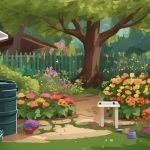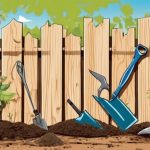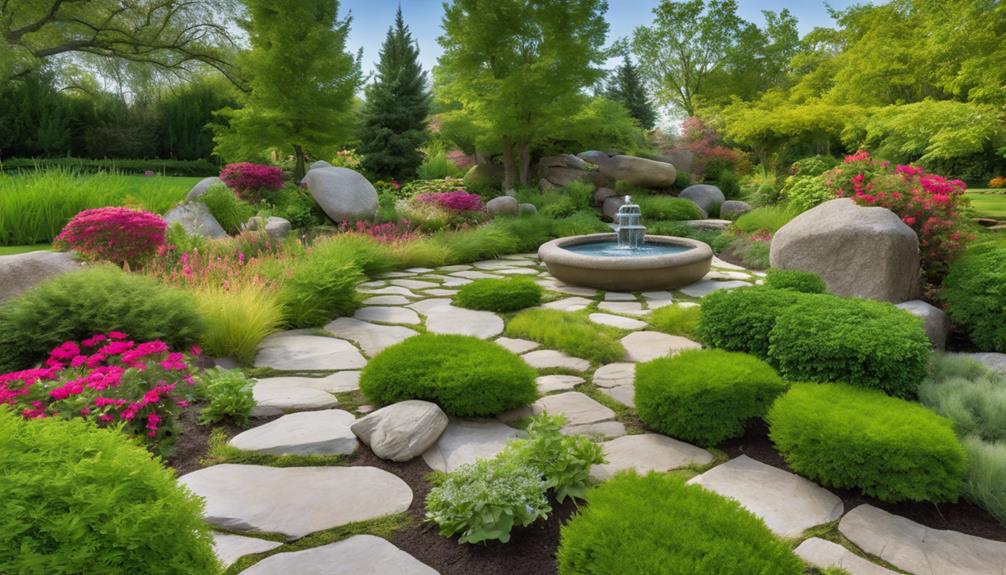
Eco-Friendly Tree Care Tips for Homeowners
12 February 2025
How to Install Wooden Fencing in Your Garden
13 February 2025Choosing combined hardscaping and landscaping services streamlines your outdoor project, creating a cohesive design that enhances both beauty and functionality.
This integrated approach minimises miscommunication and reduces delays, ensuring timely completion. Hardscaping elements, such as pathways and patios, provide structure, while landscaping adds vibrant greenery, resulting in a balanced and inviting space.
Furthermore, a unified team can swiftly address unexpected challenges, leading to cost efficiencies. Additionally, the careful selection of sustainable materials and plants contributes to long-term environmental benefits.
Exploring this combined service can greatly enhance your outdoor living experience. There are more advantages to discover.
Service Integration Benefits
Integrating hardscaping and landscaping services offers significant advantages in project management and design coherence.
A streamlined approach guarantees that all elements of outdoor spaces are harmoniously coordinated, reducing the potential for miscommunication and delays.
Furthermore, this combination enhances the overall aesthetic appeal, creating a more visually pleasing environment that complements both hard and soft landscaping features.
Streamlined Project Management
Effective project management is crucial for the success of any landscaping and hardscaping endeavour, and utilising combined services offers significant advantages.
By integrating these services, clients benefit from a single point of contact, thereby improving communication and reducing the risk of misalignment between design and execution. This streamlined approach fosters collaboration among professionals, ensuring that every aspect of the project is cohesively planned and implemented.
Moreover, it facilitates more efficient scheduling, minimising delays that often arise from coordinating multiple contractors. With a unified team, adjustments can be made swiftly in response to unforeseen challenges, ultimately leading to a more timely and cost-effective project completion.
Enhanced Aesthetic Appeal
A seamless blend of hardscaping and landscaping elements can significantly enhance the aesthetic appeal of a property. When these components are integrated thoughtfully, they create a harmonious outdoor environment that elevates the overall design.
Hardscaping features, such as patios, pathways, and retaining walls, provide structure and functionality, while landscaping elements, including plants, trees, and flowers, introduce softness and vibrancy. This combination not only enhances visual interest but also offers a cohesive look that reflects the homeowner's style.
Furthermore, effective service integration allows for careful consideration of colour palettes, textures, and spatial relationships, resulting in a landscape that is both inviting and sophisticated.
Ultimately, a well-executed design increases property value and fosters an environment of tranquillity and beauty.
Design Aesthetics and Functionality
Design aesthetics and functionality are critical elements in creating enhanced outdoor living spaces that cater to both beauty and practicality.
By integrating hardscaping and landscaping, property owners can not only elevate the visual appeal of their homes but also increase their property value through strategic design choices.
Furthermore, utilising sustainable materials in these projects promotes environmental responsibility while ensuring lasting quality.
Enhanced Outdoor Living Spaces
Creating an inviting outdoor environment involves a harmonious blend of aesthetics and functionality, transforming simple gardens into vibrant living spaces.
By integrating hard landscaping elements with soft landscaping, homeowners can achieve a sophisticated design that caters to both beauty and utility.
Consider the following enhancements to elevate your outdoor experience:
- Seamless Pathways: Well-designed walkways guide guests while augmenting the visual appeal.
- Outdoor Seating Areas: Comfortable, strategically placed seating fosters relaxation and socialisation.
- Integrated Lighting: Thoughtful illumination accentuates architectural features and improves safety.
- Water Features: Ponds or fountains introduce tranquillity and attract wildlife, enriching the sensory experience.
Together, these elements create a multifunctional outdoor space that invites enjoyment and facilitates a lifestyle immersed in nature.
Increased Property Value
Investing in combined hardscaping and landscaping services not only enhances outdoor aesthetics but also significantly boosts property value. A thoughtfully designed outdoor space amplifies the overall appeal of your property, attracting potential buyers and commanding higher prices.
Here are four key ways these services contribute to increased property value:
- Curb Appeal: A well-landscaped garden with attractive hardscaping elements creates a lasting first impression.
- Functional Outdoor Spaces: Patios, pathways, and fire pits extend living areas, making the property more versatile and appealing.
- Improved Usability: Thoughtful design fosters an inviting atmosphere for entertainment and relaxation.
- Low Maintenance: Professional landscaping reduces upkeep, appealing to buyers seeking convenience.
Together, these factors considerably enhance a property's market position and desirability.
Sustainable Material Usage
In the current environmentally conscious world, the choice of sustainable materials in hardscaping and landscaping not only promotes ecological responsibility but also enhances the overall design aesthetics and functionality of outdoor spaces.
By integrating these materials, homeowners can create beautiful environments that are both visually appealing and sustainable.
- Recycled Pavers: Durable and stylish, offering a variety of designs whilst reducing waste.
- Natural Stone: A long-lasting option that blends seamlessly with nature, enhancing aesthetics.
- Permeable Pavers: Allowing water absorption, they mitigate runoff and promote groundwater recharge.
- Native Plants: Require less water and maintenance, supporting local ecosystems whilst adding beauty.
These sustainable choices ensure that outdoor spaces are both functional and harmonious with the environment.
Initial Site Assessment
An effective initial site assessment is essential for successful hardscaping and landscaping projects.
This process involves a thorough site evaluation and planning, including an analysis of soil conditions and the implementation of creative irrigation systems.
Site Evaluation and Planning
How can a thorough site evaluation transform the potential of your outdoor space? A meticulous site appraisal lays the groundwork for exceptional hardscaping and landscaping design.
This process identifies key elements that inform strategic planning, ultimately maximising aesthetic and functional outcomes.
Consider these critical components of a site evaluation:
- Topography: Understanding elevation changes influences drainage and layout.
- Microclimates: Identifying areas with varying sunlight and moisture levels aids in plant selection.
- Existing Flora: Evaluating current vegetation informs decisions regarding preservation or removal.
- Access and Flow: Analysing traffic patterns and pathways ensures functional harmony within the space.
Soil Preparation Techniques
Effective soil preparation is vital for establishing a thriving landscape and hardscape. A thorough initial site assessment focuses on understanding the existing soil conditions, which lays the groundwork for successful installations.
The following soil preparation techniques are important:
- Soil Testing: Analyse pH levels, nutrient content, and soil texture to determine the necessary amendments.
- Clearing Debris: Remove rocks, roots, and old vegetation to ensure a clean slate for planting and construction.
- Tilling: Aerate the soil to improve drainage and encourage root growth, enhancing the overall soil structure.
- Amendment Incorporation: Integrate organic matter or fertilisers based on test results to optimise soil fertility and improve moisture retention.
These techniques equip you with the insights needed for a robust hardscape and landscape foundation.
Innovative Irrigation Systems
Following successful soil preparation, the next critical step involves reviewing the landscape's irrigation needs to ensure ideal water management.
An initial site evaluation is crucial for identifying the most effective irrigation solutions tailored to the specific environment.
- Soil Moisture Levels: Reviewing moisture retention and drainage characteristics informs irrigation frequency and volume.
- Plant Water Requirements: Understanding the specific needs of diverse plant species ensures optimal hydration.
- Sunlight Exposure: Assessing sun and shade patterns helps determine evaporation rates and irrigation schedules.
- Topography: Analysing slopes and contours assists in designing efficient water distribution systems.
Time and Cost Efficiency
Recognising the importance of time and cost efficiency in landscaping projects can greatly enhance the overall success of outdoor transformations. By opting for combined hardscaping and landscaping services, clients can streamline processes, minimise disruptions, and optimise resource allocation. This integrated approach not only reduces labour costs but also shortens project timelines, allowing for quicker realisation of desired outcomes.
| Aspect | Benefits |
|---|---|
| Project Coordination | Seamless integration of design elements |
| Time Savings | Reduced project duration |
| Cost Reduction | Lower total expenses |
| Resource Optimisation | Efficient use of materials and manpower |
| Improved Value | Increased property appeal |
Adopting this strategy guarantees that investments yield maximum returns, ultimately enhancing the quality and longevity of outdoor spaces.
Plant Selection Strategies
Effective plant selection is critical for creating sustainable landscapes that thrive in their environments.
By integrating native plants, choosing drought-resistant varieties, and incorporating pollinator-friendly options, landscape designers can enhance both ecological health and aesthetic appeal.
This strategic approach not only supports local biodiversity but also ensures long-term viability and reduced maintenance requirements.
Native Plant Integration Techniques
A thoughtful approach to native plant integration can greatly enhance the ecological health and aesthetic appeal of a landscape.
By employing strategic selection methods, one can create harmonious ecosystems that thrive in local conditions.
Consider the following techniques:
- Ecological Compatibility: Select plants that support local wildlife, such as pollinators and birds, thereby enhancing biodiversity.
- Soil Adaptation: Choose species that naturally thrive in the existing soil types, reducing the need for amendments.
- Seasonal Interest: Incorporate a variety of plants that provide visual interest throughout all seasons, from blooming flowers to vibrant autumn foliage.
- Layering Techniques: Use a tiered planting approach to optimise space and create depth, ensuring taller plants do not overshadow shorter ones.
These strategies lay the groundwork for a resilient and engaging landscape.
Drought-Resistant Plant Choices
In the face of increasing climate variability, selecting drought-resistant plants is essential for creating sustainable landscapes that require minimal water input.
These plants not only thrive in arid conditions but also contribute to ecological balance and aesthetic appeal.
Here are four exemplary drought-resistant options to consider:
- Agave – A succulent that stores water, making it ideal for dry environments.
- Lavender – Aromatic and visually appealing, it flourishes in well-drained soils.
- Sedum – This hardy ground cover offers vibrant colours and low maintenance.
- Russian Sage – A resilient perennial that adds height and texture with minimal water requirements.
Pollinator-Friendly Plant Options
Creating a sustainable landscape involves not only selecting drought-resistant plants but also incorporating species that support local pollinators.
By choosing the right plants, you can enhance biodiversity while promoting ecological balance. Here are four pollinator-friendly options to consider:
- Echinacea purpurea (Purple Coneflower) – Attracts bees and butterflies, thriving in sunny locations.
- Asclepias tuberosa (Butterfly Weed) – A nectar source for monarchs and other butterflies, ideal for well-drained soils.
- Lavandula angustifolia (English Lavender) – Known for its aromatic flowers, it draws bees and is drought-tolerant.
- Rudbeckia hirta (Black-Eyed Susan) – A hardy perennial that blooms throughout the summer, providing sustenance for diverse pollinators.
Incorporating these species fosters a vibrant, resilient ecosystem in your landscape.
Unexpected Weather Disruptions
Unexpected weather disruptions can significantly impact landscaping and hardscaping projects, necessitating proactive measures in design and material selection.
Utilising weather-resistant materials and implementing adaptive design techniques are crucial for minimising damage and ensuring longevity.
Moreover, resilient landscape design strategies can help maintain aesthetic appeal and functionality despite unforeseen climatic challenges.
Weather-Resistant Material Selection
The selection of weather-resistant materials is crucial for guaranteeing the longevity and durability of hardscaping and landscaping projects. Utilising materials that can withstand unpredictable weather conditions minimises maintenance and preserves aesthetic appeal.
Consider the following materials for improved resilience:
- Composite Decking: Offers resistance to moisture and UV rays, preventing warping and fading.
- Natural Stone: Provides durability against freeze-thaw cycles while maintaining a timeless appearance.
- Permeable Pavers: Facilitates effective drainage, reducing erosion and water pooling.
- High-Quality Sealants: Protects surfaces from water infiltration and extends the life of various materials.
Choosing the right weather-resistant materials not only enhances performance but also ensures that your investment remains intact throughout changing climates.
Adaptive Design Techniques
Incorporating adaptive design techniques is crucial for addressing the challenges posed by unexpected weather disruptions in hardscaping and landscaping projects.
Such techniques enhance resilience and ensure longevity, providing flexibility in design to accommodate changing conditions.
Key considerations include:
- Site Analysis: Evaluating microclimates and drainage patterns to inform material selection and placement.
- Diverse Plant Selection: Utilising a variety of plant species that can thrive under fluctuating environmental conditions.
- Modular Hardscaping: Implementing modular systems that can be easily adjusted or replaced as necessary.
- Water Management Strategies: Designing effective drainage and irrigation systems to mitigate erosion and flooding risks.
Resilient Landscape Design Strategies
Effective resilient landscape design strategies are essential for mitigating the impacts of unpredictable weather disruptions on outdoor environments. By incorporating these strategies, landscapes can withstand extreme conditions while maintaining their aesthetic and functional value.
Here are four key strategies to consider:
- Diverse Plant Selection: Utilise a variety of species to ensure resilience against pests and diseases.
- Soil Management: Implement practices that enhance soil health and drainage, thereby reducing erosion and waterlogging.
- Water Management Systems: Design efficient irrigation systems and rain gardens to manage stormwater effectively.
- Structural Elements: Integrate hardscaping features, such as retaining walls and permeable pavements, to provide stability and mitigate flooding.
Implementing these strategies ensures a landscape that thrives despite the challenges posed by an ever-changing climate.
Why Choose TKL Birmingham Gardener
Choosing TKL Birmingham Gardener means opting for a team that combines expertise with a deep understanding of local landscapes.
Our professionals excel in both hardscaping and landscaping, ensuring a seamless integration of structures and flora that enhances aesthetic appeal and functionality.
We prioritise sustainable practices, utilising native plants and eco-friendly materials to create resilient environments.
Our tailored approach allows us to address specific client needs, fostering designs that reflect individual preferences while adhering to local regulations.
By choosing TKL, clients benefit from meticulous attention to detail and a commitment to excellence that transforms outdoor spaces into masterpieces.
Trust in our experience to elevate your property, ensuring it not only meets but exceeds your expectations.
Experience the TKL difference today.
Common Client Questions Answered
Navigating the complexities of hardscaping and landscaping can raise numerous questions for clients seeking to enhance their outdoor spaces. One common inquiry pertains to the integration of both services—clients often wonder how hardscaping elements can effectively complement landscaping features.
Another frequent question revolves around budgeting; clients seek clarity on the costs associated with each component and the potential for value enhancement.
Furthermore, many clients inquire about the maintenance requirements of integrated designs, wishing to understand the long-term care needed.
Finally, timelines for project completion are often discussed, as clients desire to know how long the transformation will take.
Addressing these inquiries fosters informed decisions and ultimately leads to successful outdoor improvements.
Final Thoughts and Recommendations
Understanding the common questions clients have about hardscaping and landscaping is crucial for making informed decisions. A combined service approach not only enhances aesthetic appeal but also maximises functionality.
To ensure you optimise your investment, consider the following recommendations:
- Assess Your Space: Evaluate the dimensions and features of your property to identify opportunities for enhancement.
- Define Your Vision: Clearly articulate your desired outcomes, including style, function, and maintenance preferences.
- Choose Quality Materials: Invest in durable materials that complement your landscape for longevity and reduced upkeep.
- Engage Professionals: Collaborate with experienced designers and contractors to achieve a cohesive and harmonious design.



